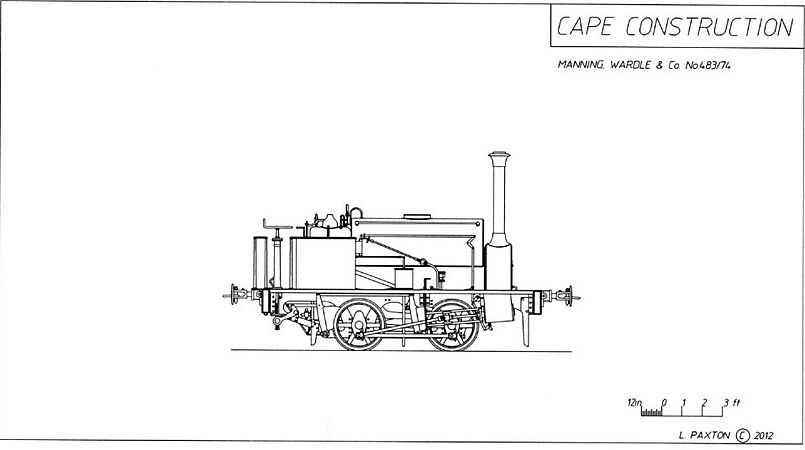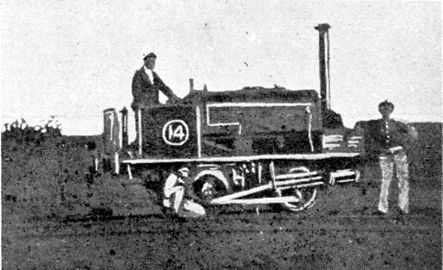CGR 0-4-0ST 1874
| CGR 0-4-0ST 1874 | |
|---|---|
|
Cape Government Railways 0-4-0ST of 1874, no. M14 | |
| Type and origin | |
| Power type | Steam |
| Designer | Manning Wardle & Company |
| Builder | Manning Wardle & Company |
| Serial number | 483 |
| Build date | 1874 |
| Specifications | |
| Configuration | 0-4-0ST |
| Gauge | 3 ft 6 in (1,067 mm) Cape gauge |
| Locomotive weight | 8 long tons (8.1 t) w/o [1] |
| Fuel type | Coal |
| Cylinders | Two |
| Career | |
| Operator(s) | Cape Government Railways |
| Number in class | 1 |
| Number(s) | M14 |
| Official name | Possibly "Mliss" |
| Delivered | 1874 |
| First run | 1874 [2][3] |
The CGR 0-4-0ST of 1874 is a South African steam locomotive from the pre-Union era in the Cape Colony.
In 1874 a single Cape gauge saddle-tank locomotive with a 0-4-0 wheel arrangement was placed in service by the contractors to the Port Elizabeth and Uitenhage Railway Company for the construction of railway lines into the interior. When construction work was completed, the locomotive was taken onto the roster of the Midland System of the Cape Government Railways.[2][4]
Manufacturer
In 1874 a third Cape gauge locomotive, built by Manning Wardle & Company, was delivered through the London agents W. Bailey Hawkins & Co. to the contractors to the Port Elizabeth and Uitenhage Railway Company in Port Elizabeth. The locomotive was of a smaller design than the earlier two 0-4-0ST locomotives of 1873.[2][3][4]
Service
Work on railway expansion from Port Elizabeth into the interior was already underway in 1874 and the locomotive was put to work as construction engine on the mainline that was being built northward from Swartkops via Barkly Bridge, Addo, Alicedale and Cookhouse to Cradock.[3][5]
At some stage around April 1876, when construction work was completed to Sandflats between Coerney and Alicedale, the locomotive was taken over from the contractors by the Cape Government Railways, along with six other contractor's locomotives, and was allocated number M14 on the Midland System. In 1877, when Swallow's Cutting was being excavated near Middleton on the section north of Alicedale, the locomotive was transported to the construction site by government bullock cart. This line reached Cookhouse in 1880.[2][3][4][5][6]
Locomotive named "Mliss"
Reference has been made in literature to a locomotive named "Mliss". In an Uitenhage centenary publication the first three construction locomotives on the Midland System are described as two engines named "Pioneer" and "Little Bess" that each weighed 14 tons, and a third engine named "Mliss" after "one of Bret Harte's charming heroines", that was imported about the same time and that weighed only eight tons.[1][7]
To date the engine "Mliss" could not be positively identified. While no. M14 is the most likely candidate, too little is known as yet about the engine itself to positively identify it as Mliss.[3]
Drawing
Since the only known existing picture of this locomotive is heavily touched up, the drawing by Leith Paxton below, based on this picture, illustrates better what this locomotive may have looked like.
-

Drawing of Cape Government Railways 0-4-0ST of 1874, no. M14
See also
- CGR 0-4-0ST 1873
- The 0-4-0 wheel arrangement
- South African locomotive history
- List of South African locomotive classes
References
|
- ↑ 1.0 1.1 p. 145 of "Uitenhage Past and Present"
- ↑ 2.0 2.1 2.2 2.3 C.G.R. Numbering Revised, Article by Dave Littley, SA Rail May–June 1993, pp. 94-95.
- ↑ 3.0 3.1 3.2 3.3 3.4 Railway History of South Africa no. 2 - Early Locomotives of the Cape Government Railway, Article by Leith Paxton, The Uloliwe, Vol 4 no 1, January 2013, pp. 62-63.
- ↑ 4.0 4.1 4.2 Pioneer, Little Bess & Mliss
- ↑ 5.0 5.1 The South African Railways - Historical Survey. Editor George Hart, Publisher Bill Hart, Sponsored by Dorbyl Ltd., Published c. 1978, p. 12.
- ↑ p. 144 of "Uitenhage Past and Present"
- ↑ Uitenhage Past and Present - Souvenir of the Centenary - 1804-1904. Sellick, W.S.J. Publisher W.S.J. Sellick at the "Uitenhage Times" Office, Cape Colony. Published 1904, pp. 144-146.
